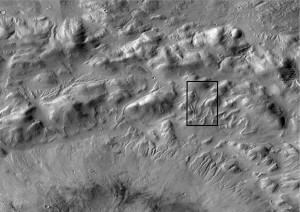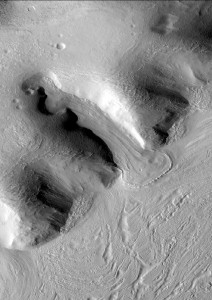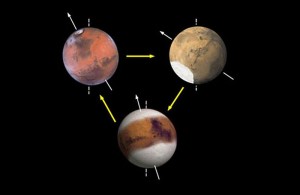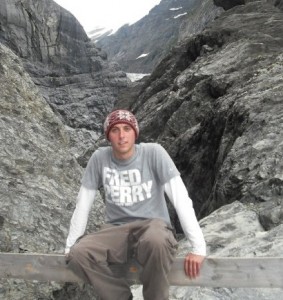Antarctica is frequently compared with Mars. But are they actually that similar, even though both have a dry, cold climate and glaciers and polar ice caps? Here, Stephen Brough from Aberystwyth University explains the key points of glaciers on Mars.
Is there ice on other planets? | Evidence for glaciers on Mars | Ice ages on Mars | Summary and outlook | About the Author | Further Reading | References | Comments |
Is there ice on other planets?

Do glaciers and ice caps, like those we see on Earth, exist on other planets? Satellite images from our nearest neighbour, Mars, show both polar ice caps and glacier-like forms located in the mid-latitudes (30°-60°). Understanding these enigmatic forms helps us to unravel the complex climatic history of the Red Planet (Fig. 1). These vast reservoirs of ice could also be the perfect place to hunt for microbial life (microbes being found even at great depths within the ice in Antarctica), as well as being a valuable source of water for sustained human exploration1,2.
Evidence for glaciers on Mars
Polar regions

Water ice and Carbon Dioxide ice
Both the north and south polar regions of Mars are covered in a permanent cap of ice, similar to modern day Antarctica. Interestingly, the climatic conditions on Mars not only allow for water ice (H2O) but also carbon dioxide ice (CO2) to form. Frost composed of frozen water and carbon dioxide even forms in cold mornings (Fig. 2). This is mainly a reflection of the cold temperatures experienced at the polar regions on Mars and that the atmosphere is dominated by carbon dioxide (~95% by volume).
Permanent polar ice

The permanent ice cap at the North Pole is largely composed of water ice3. This huge ice cap has a diameter of 1100 km, with most of the region north of 80°N being ice-covered1 (Fig. 3). The ice cap at the South Pole is also composed of water ice, but it is overlain by a thick veneer of carbon dioxide ice4,5. This smaller ice cap has a diameter of only 400 km, but thicker ice here means that the volume of ice in both ice caps is more or less the same6. During the winter a seasonal covering of freezing carbon dioxide blankets both ice caps, meaning that ice reaches 60°N in the north and 65°S in the South4.
Mid-latitudes

Between 30o – 60o latitude in both hemispheres, a distinct suite of landforms have been identified and classified as glacial in origin7,8. The appearance of these landforms has drawn comparison with glaciers on Earth, as they strongly suggest down-slope flow and deformation (Fig. 4). Radar profiles have also shown them to be composed primarily water ice9, further backing up their glacial interpretation. Such attributes led to the landforms being term “viscous flow features”7 (see review of Souness and Hubbard10). One particular sub-type of these viscous flow features are visually and contextually similar to valley glaciers on Earth, and they have been termed “glacier-like forms”11,12.
Glacier-like forms

Glacier-like forms appear to converge from cirque-like alcoves or valleys, move material in a downslope direction, and then merge with the surrounding topography, commonly forming an elongate tongue with raised moraine-like ridges (Fig. 5). In total over 1300 glacier-like forms have been identified in the mid-latitudes of Mars8 and on-going research is indicating that present glacier-like forms may represent the degraded remains of a once large ice mass2,13.
In Fig. 5 opposite, you can see a glacier-like form in Protonilus Mensae in the northern hemisphere on Mars. This particular glacier-like form is distinctly similar in morphology to a valley glacier on Earth. The glacier-like form appears to be formed in alcoves with mass being transported down valley to the glacier-like form terminus. The terminus itself spreads out once it escapes the confines of the valley walls.
Several glacial features are visible on the glacier-like form surface. Longitudinal structures similar to longitudinal foliation can be seen almost the whole glacier-like form surface, small rifts on the left are similar to crevasses and the terminus is bound by a raised, moraine-like ridge.
Ice ages on Mars
So, where did these mid-latitude martian glacier-like forms come from? The martian climate is currently cold and dry, with the thin martian atmosphere providing poor insulation for the Sun’s radiation. The conditions on Mars today are unfavourable for the formation and preservation of water ice on the surface outside of the polar regions for long periods of time3.
Causes of ice ages

Much like the Earth, the orbit of Mars as it travels around the Sun periodically varies. Changes in Mars’ orbit means that more or less energy is received at the Poles, and it is these changes that have led to the hypothesis that Mars has experienced one or more ice ages14,15. For Mars, periods of high obliquity (the angle of tilt of the axis of rotation) seem to result in ice ages in the mid-latitudes14 (Fig. 6).
In the recent geological past, the angle of tilt of the axis of rotation on Mars has ranged between 14° to 48°16. Conditions are favourable for ice deposition when the obliquity exceeds 30°14. During these periods of high obliquity, increased solar radiation causes ice locked in the polar caps of Mars to sublimate (change from a solid to gas, without becoming liquid) and shift towards the equator as a result of elevated moisture contents. The resulting atmospheric water vapour condenses and is then deposited into or onto the surface of Mars down to latitudes as low as 30o in both hemispheres15.
Summary and outlook
The view that Mars is an inactive, redundant mass has been challenged and revolutionised since Mariner 9 first returned direct images of the martian surface. We can now provide comprehensive evidence for not only glacial processes but a diverse range of other geologic phenomena on Mars4.
Ice, in all of its forms, has played and will continue to play an important role in altering the surface of Mars and its atmospheric composition. Notwithstanding, there are still a number of key debates and unknown parameters to explore (see review of Hubbard and Souness, 2012). An intriguing thought may not be what can Earth based glaciers tell us about glaciers on Mars, but what can glaciers on Mars possibly tell us about our glaciers (long term future) on Earth?
To end this post I think it fitting to leave you with the words of Charles Darwin (Voyage of the Beagle, 1845):
How great would be the desire in every admirer of nature to behold, if such were possible, the scenery of another planet!
About the author

Stephen Brough is a Ph.D. student at Aberystwyth University where he studies the inspirational landscapes of Mars. His research focuses upon constraining the physical properties of glacial-like forms, with the hope that such information can then be used to model their behaviour. You can follow him on Twitter, @GlaciersOnMars, for more Mars, space and glacial ramblings.
Further reading
If this post has inspired you to think about ice on Mars, or Mars in general, below are a list of useful links which will open up a whole world of fun and best of all they are free!
Images
- Hi Resolution Image Science Experiment (~25 cm/pixel) – http://hirise.lpl.arizona.edu/
- Image locator. Search for every image ever taken of Mars by browsing on a map or by searching for a unique image with an image ID – http://global-data.mars.asu.edu/
Image viewers / Geospatial information system
- HiWISH – http://hirise.lpl.arizona.edu/hiview/
- JMars – http://jmars.asu.edu/
- 3DEM – http://www.hangsim.com/3dem/
Datasets
USGS – http://webgis.wr.usgs.gov/pigwad/down/mars_dl.htm
Mars Science Laboratory (Curiosity Rover): @MarsCuriosity
HiRISE: @HiRISE
General Mars: @marstoday
